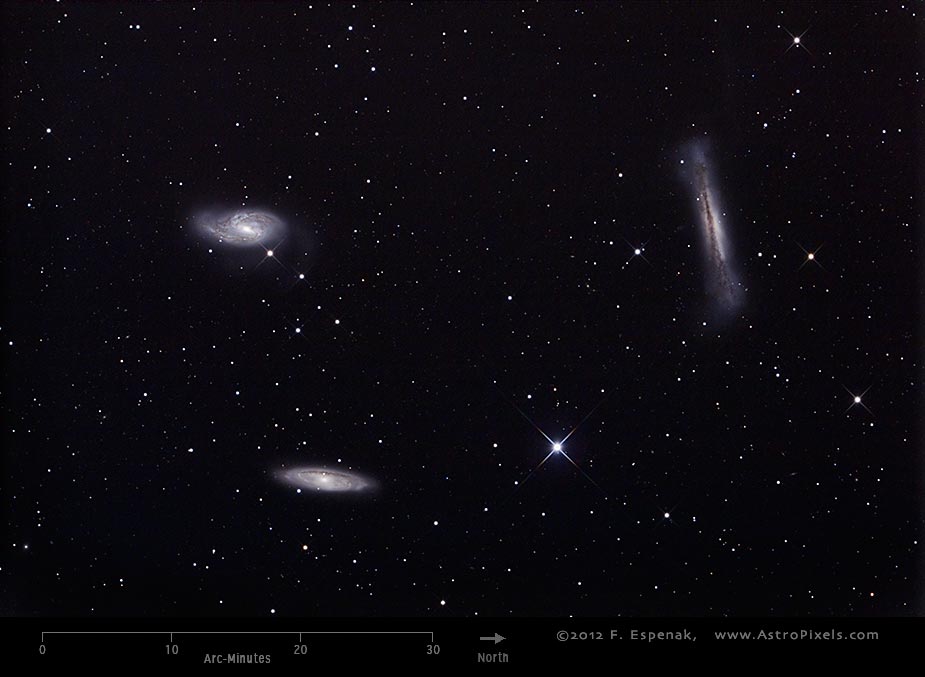M65, M66 & NGC 3628 ("Trio in Leo")
The three galaxies commonly known as the "Trio in Leo" form a gravitationally interacting system. In fact, NGC 3628 is so strongly perturbed by its neighbors that its cental dust lane appears twisted. The group are best seen during the spring when the constellation Leo is visible all night long. The Messier Spring Star Chart shows the position of all Messier objects visible during the spring.
The image above shows the uncropped view of M65 (bottom left), M66 (top left) and NGC3628 (right) through the ASA N12 Corrected Newtonian Astrograph (North is to the right). For wider view of this galaxy grouping using the Takahashi E-180 Astrograph, see M65, M66 & NGC3628 (TAK E-180) .
M65
Messier 65 or M65 (also designated NGC 3623) is a spiral galaxy in the constellation Leo. It has an apparent visual magnitude of 9.3 and its angular diameter is 8x1.5 arc-minutes. M65 lies at an estimated distance of 35 million light years. The Equinox 2000 coordinates are RA= 11h 18.9m, Dec= +13° 05´.
This spiral galaxy was discovered by Messier in 1780. Together with M66 and NGC 3628, the three galaxies are referred to as the Leo Triplet or the Trio in Leo. According to Stoyan et al. (2010), the distance of M65 is 32.8 million light years and its diameter is 94,000 light years.
For more information, see the Messier Catalog as well as specific entries for M65 in Wikipedia, SEDS and APOD.
M66
Messier 66 or M66 (also designated NGC 3627) is a spiral galaxywith an apparent visual magnitude of 8.9 and an angular diameter is 8x2.5 arc-minutes. M66 lies at an estimated distance of 35 million light years. The Equinox 2000 coordinates are RA= 11h 20.2m, Dec= +12° 59´.
This spiral galaxy was discovered by Messier in 1780. Together with M65 and NGC 3628, the three galaxies are referred to as the Leo Triplet or the Trio in Leo. The spiral arms of M66 appear deformed due to the gravitational effects of its neighbor M65. According to Stoyan et al. (2010), the distance of M66 is 32.8 million light years and its diameter is 87,000 light years.
For more information, see the Messier Catalog as well as specific entries for M66 in Wikipedia, SEDS, and APOD.
NGC 3628
NGC 3628 is a spiral galaxy with an apparent visual magnitude of 9.5 and an angular diameter is 15×3.6 arc-minutes. The Equinox 2000 coordinates are RA= 11h 20.3m, Dec= +13° 35´.
NGC 3628 was discovered by William Herschel in 1784. Its distance is estimated at 35 million light years and it has a long tidal tail 300,000 light-years in length. Its most conspicuous feature is the broad and obscuring band of dust located along the edge of its spiral arms, that transects the galaxy. The dust band also appears twisted because NGC 3628 has been gravitaionally perturbed by its neighbors M65 and M66.
For more information, see the specific entries for NGC 3628 in Wikipedia, SEDS, and APOD.
Technical Details
- Objects: M65, M66 and NGC 3628
- Other Names: M65 (NGC 3623), M66 (NGC 3627)
- Object Type: spiral galaxy
- Object Data: M65: Apparent Magnitude = 9.3, Angular Size = 8x1.5 arc-minutes
M66: Apparent Magnitude = 8.9, Angular Size = 8x2.5 arc-minutes
NGC 3628: Apparent Magnitude = 9.5, Angular Size = 15×3.6 arc-minutes - Object Position (Equinox 2000): M65: RA= 11h 18.9m, Dec= +13° 05´
M66: RA= 11h 20.2m, Dec= +12° 59´
NGC 3628: RA= 11h 20.3m, Dec= +13° 35´ - Date/Time: 2012 Mar 22 at 04:58 UTC
- Location: Bifrost Astronomical Observatory, Portal, AZ
- Mount: Astro-Physics 1200GTO
- Telescope: ASA N12 Corrected Newtonian Astrograph
- Camera: Canon EOS 550D (Rebel T2i) (modified with a Baader UV/IR filter)
- Field of View: 71.0 x 47.4 arc-minutes at 0.82 arc-sec/pixel (web version: 4.6 arc-sec/pixel)
- Exposure: 10 x 480s, f/3.6, ISO 800
- File Name: M65M66-A01w.jpg
- Processing (Adobe Camera Raw): Flat Field Subtraction, Noise Reduction, White Balance
- Processing (Photoshop CS5): Average Images, Curves, Noise Reduction, High Pass Filter, Unsharp Mask
- Original Image Size: 3454 × 5179 pixels (17.9 MP); 11.5" x 17.3" @ 300 dpi
- Rights: Copyright 2012 by Fred Espenak. All Rights Reserved. See: Image Licensing.
